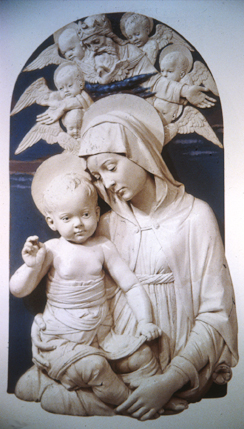
'Madonna and Child', Majolica glazed terra cotta, by Andrea della Robbia, Firenze, around 1450 CE, 38" ht.
ART 198 - HISTORY OF WORLD CERAMICS
| In addition to the use of the majolica technique for tableware, istoriato style piatti da pompa, and pavement tile, Luca della Robbia and his nephew, Andrea created religious sculpture and portraiture using the method. This religious panel, in glazed terra cotta, is by Andrea, working in their Florence workshop in the latter half of the 15th century. Andrea was an especially gifted sculptor, and captured nuance of facial detail with unusual skill. The work does not appear initially to be ceramic, but possibly marble or alabaster, but ceramic it is. The opaque white glaze completely covers the brick colored terra cotta clay. An unique variation on the majolica technique, developed originally by Luca was to add the coloring oxide pigments directly into the glaze, and then coloring areas of the composition with these solid colored glazes, rather than painting the oxides onto the white glaze. Figures are almost always left white in the della Robbia works. They were very prolific and their work graces many an Italian cathedral. | 'Madonna and Child', Majolica glazed terra cotta, by Andrea della Robbia, Firenze, around 1450 CE, 38" ht. |
|
|